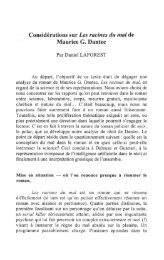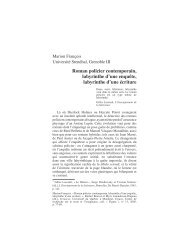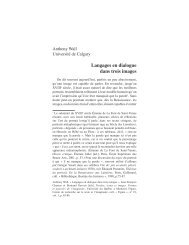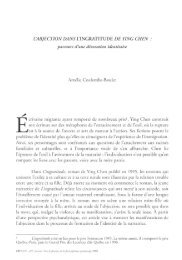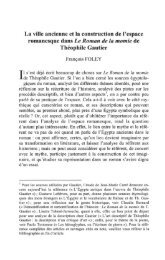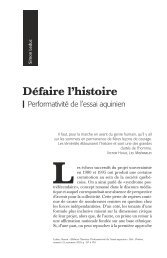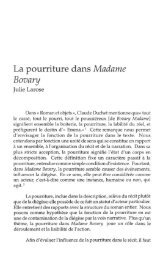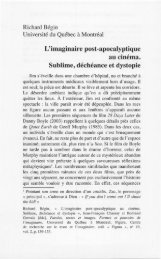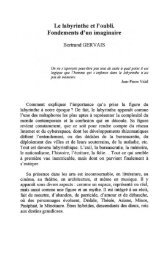Seeing and Believing in Dostoevsky's The Idiot - Observatoire de l ...
Seeing and Believing in Dostoevsky's The Idiot - Observatoire de l ...
Seeing and Believing in Dostoevsky's The Idiot - Observatoire de l ...
You also want an ePaper? Increase the reach of your titles
YUMPU automatically turns print PDFs into web optimized ePapers that Google loves.
SEEING AND BELlEVING<br />
of the beauty of the Epanch<strong>in</strong> girls, the photographie portrait<br />
of Nastasya Filippovna is <strong>in</strong>troduced, provok<strong>in</strong>g sc<strong>and</strong>ai,<br />
outrage, <strong>and</strong> awe. How can such a comb<strong>in</strong>ation of beauty <strong>and</strong><br />
suffer<strong>in</strong>g exist? It is here that A<strong>de</strong>laida famously eomments<br />
about Nastasya Filippovna: "Such beauty has power.... You<br />
can overturn the world with such beauty."14 Although applied<br />
here to the icon-portrait, these words equally <strong>de</strong>seribe the<br />
"double thoughts," the contradictory nature of the beauty that<br />
not only Nastasya Filippovna but Myshk<strong>in</strong> reveal-that they<br />
bear <strong>and</strong> bare-to the world.<br />
<strong>The</strong> <strong>in</strong>abil ity to represent i<strong>de</strong>al, non-experiential beauty<br />
cornes up aga<strong>in</strong> <strong>in</strong> Book Two, this time <strong>in</strong> connection to<br />
Myshk<strong>in</strong> himself. By now Aglaya Epanch<strong>in</strong> is un<strong>de</strong>r the<br />
ambiguous spell of the pr<strong>in</strong>ce, a1ternately lov<strong>in</strong>g <strong>and</strong> hat<strong>in</strong>g,<br />
worship<strong>in</strong>g <strong>and</strong> scorn<strong>in</strong>g him. In her m<strong>in</strong>d she has ma<strong>de</strong> of<br />
him a comb<strong>in</strong>ation of Pushk<strong>in</strong>'s Poor Knight <strong>and</strong> Cervantes's<br />
Knight ofthe Sorrowful Countenance. She has even, we learn,<br />
asked her sister A<strong>de</strong>laida to pa<strong>in</strong>t him on the basis of her<br />
<strong>de</strong>scription. But A<strong>de</strong>laida says it can't be done:<br />
"How could 1 pa<strong>in</strong>t it? And whom? <strong>The</strong> subject<br />
says about this 'poor knight':<br />
From his face the visor<br />
He ne'er raised for anyone.<br />
What sort of face could it be, then? What should<br />
1 pa<strong>in</strong>t-a visor? An anonymity?"15<br />
the imitation of a pre-existent, rule-bound natural or<strong>de</strong>r.<br />
14 Dostoevsky, <strong>The</strong> <strong>Idiot</strong>, 80, Ru ssian Aca<strong>de</strong>my edition, 69. <strong>The</strong><br />
Russian reads: TaKlUI KpacOTa - CIMa - ropSl4o CKa3aJIa Ai1eJtaHAa <br />
CTaKOIO Kpac(YroH MOlKHO MHp nepesepHyTb.<br />
l' Dostoevsky, <strong>The</strong> <strong>Idiot</strong>, 247, Russian Aca<strong>de</strong>my edition , 206.<br />
Pushk<strong>in</strong> 's Russian verse reads: C JlHl\a CTaJIbHOH peWëTKH 1HH npeA<br />
KeM He nOAbiMaJI. Significantly, although beyond the scope of these<br />
remarks, Nastasya Filippovna is able to create an imag<strong>in</strong>ary portrait<br />
of Myshk<strong>in</strong> (as Christ). See Book Three, Chapter 10.<br />
[116]



